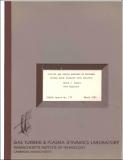Flutter and forced response of mistuned rotors using standing wave analysis
Author(s)
Bundas, David J.; Dugundji, John
Download916503824.pdf (4.052Mb)
Other Contributors
Massachusetts Institute of Technology. Gas Turbine and Plasma Dynamics Laboratory
Metadata
Show full item recordAbstract
The torsion flutter and forced response of tuned and mistuned cascades is examined using a standing wave approach, as opposed to the traditional traveling wave approach used in cascades aerodynamic models. The motion of the blades and the corresponding cascade aerodynamic loads are expressed in terms of standing wave modes and arbitrary transient motion, by fitting the sinusoidal force coefficients in terms of ratios of polynomials in the Laplace transform variable, sometimes referred to as Pade approximants. Whitehead's two dimensional, incompressible aerodynamic model is expressed in this transient form and is used to solve the flutter and forced response problems. Results obtained with the transient, standing wave analysis for the flutter and forced response are similar to those obtained by traveling wave analyses, but they yield the transient decay rate associated with vibrations of the blades, as opposed to the structural damping required for flutter obtained by the traveling method.
The standing wave analysis presented here may prove to be more versatile for dealing with certain applications such as mistuned rotors, "localized" blade flutter, low engine order excitation, transient impulses on the rotor, and coupling in with forced response and dynamic shaft problems.
Description
First published as the author's thesis (M.S.) in the M.I.T. Dept. of Aeronautics and Astronautics, 1983 Massachusetts Inst. of Tech. --Microfiche header March 1983 N84-24586 --Microfiche header NASA Grant no. NAG3-214 Includes bibliographical references
Date issued
1983Publisher
Cambridge, Mass. : Gas Turbine & Plasma Dynamics Laboraotry, [1983]
Series/Report no.
N 84-24586NASA contractor report ; NASA CR-173555GT & PDL report ; no. 170